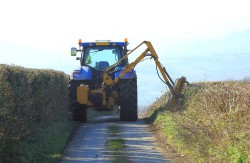Bioenergy production from an under-utilised resource
The EU-funded greenGain(opens in new window) project aimed to strengthen the energy production of woody and herbaceous biomass from landscape conservation and maintenance work (LCMW) carried out in the public interest. The biomass used involved any material predominantly produced from nature conservation and landscape management, but not from energy crops. This type of biomass is typically generated by subcontracted companies, small local authorities, farmers and forest owners during the maintenance of roadsides, watercourses, parks, cemeteries, nature reserves and even private gardens. Main groups targeted by the project included regional and local players responsible for maintenance and conservation work and biomass residue management. The project focused on service providers such as farmers and forest owners, their associations, NGOs and energy providers and consumers. The most important challenges of working with LCMW include the scattered nature of the supply, seasonal fluctuations, and poor feedstock quality, requiring pre-treatment such as sieving or drying. Furthermore, legal requirements for waste management are often unclear, and information concerning the type, amount and location of the biomass is generally lacking. An under-exploited feedstock resource Project partners developed strategies to build up reliable knowledge on the local availability of these feedstocks and know-how on issues ranging from logistics to storage and sustainable conversion pathways for the transformation of LCMW to renewable energy (heat and energy products). “The aim is to raise awareness of this still widely underused biomass resource and increase public acceptance of its collection and usage to produce heat and electricity,” says project contact Diego Piedra-Garcia. In addition, researchers addressed political, legal and environmental aspects in model regions in Czechia (Kněžice municipality and Microregion Vltavotýnsko), Germany (County Friesland and County Rotenburg), Spain (Bajo Aragón county and Matarraña county) and Italy (Trasimeno region). Despite the hurdles outlined, LCMW is an attractive biomass feedstock for businesses. “Utilising this biomass arising from the regular management of public areas can contribute to the provision of local renewable energy production,” explains Piedra-Garcia. Moreover, selling the biomass as a feedstock, or the energy generated from it, can also provide financial compensation for maintenance costs, and regional and local actors who can profit directly from LCMW biomass utilisation. Additionally, it will contribute to the reduction of GHG emissions due to the subsequent decrease in fossil fuel use. Renewable energy at local level Regional and local groups responsible for maintenance and conservation work were targeted as they also manage the collected LCMW biomass. For this purpose, general guidelines were drawn up together with a handbook on LCMW supply chains. The value of greenGain was ensured via communication with the wider public and the industrial, scientific and policy communities. Therefore, greenGain will help private and public actors as well as stakeholders to develop pilot energy projects. The results are presented in a good practice database on categorised supply chains, detailing technologies, utilisation pathways and economic data. The project also contributes to the reduction of greenhouse gas emissions through the use of LCMW-based biofuels and the promotion of direct energy conversion of LCMW biomass. “Part of the energy resulting from the exploitation of LCMW will be used at the local level for heating municipal buildings, either directly or by using heat from processing plants,” claims Piedra-Garcia. Finally, the sustainable use of renewable resources in the form of LCMW will contribute to the protection of biodiversity, by maintaining natural features of the landscape, such as hedgerows and wetlands.







